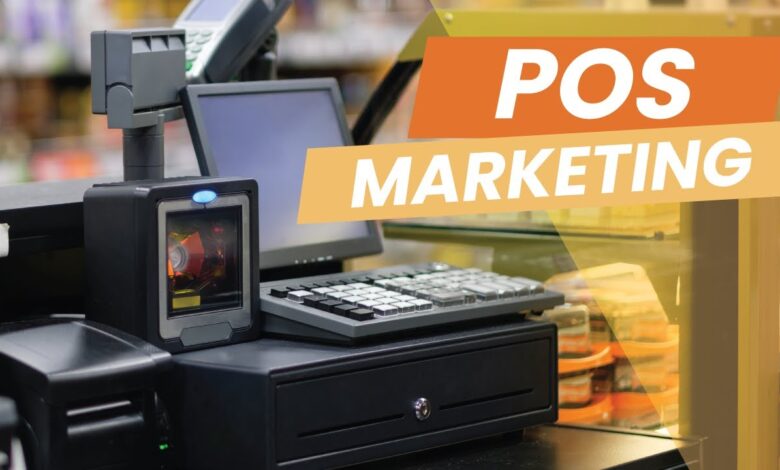Principles of Successful Point of Sale Advertising

Point of sale advertising is a marketing strategy that uses in-store displays to encourage customers to buy products at the point of sale. POS advertising is a key part of POS marketing, which is primarily used in brick-and-mortar stores. The goal of POS advertising is to increase sales by making it easy for customers to find and purchase products, and by encouraging impulse buying.
Introduction to POS Advertising
POS is a crucial opportunity to influence customer behavior and maximize in-store sales.
POS represents a pivotal stage in the customer buying process, and customers are most receptive to purchasing decisions at the point of sale advertising.
POS ads are designed to influence the customer’s purchase decision at the critical moment when they are ready to buy. POS advertising can encompass both digital and physical touchpoints within the store environment.

point of sale advertising
- Effectively executed Point of Sale advertising can:
a. Drive impulse purchases
b. Cross-sell and upsell complementary products
c. Introduce new products or promotions
d. Reinforce brand messaging and build customer loyalty
Key Benefits of Effective Point of Sale Advertising
Effective POS advertising can play in boosting sales, reinforce brand messaging, and drive customer engagement.
A. Drives Impulse Purchases
- POS ads capitalize on the customer’s heightened purchase intent at the point of sale.
- Strategically placed ads can entice customers to add unplanned items to their cart.
- Impulse purchases can significantly boost overall in-store sales.
B. Reinforces Brand Messaging
- POS advertising allows businesses to maintain a consistent visual identity.
- Repeated exposure to brand elements at the POS strengthens customer recognition.
- Effective POS ads help to cultivate brand loyalty and positive associations.
C. Increases Average Order Value
- POS ads can promote complementary or cross-sell products.
- Suggestive selling through POS touchpoints encourages larger basket sizes.
- Higher average order value translates to greater revenue per customer.
D. Promotes New Products or Offers
- POS is an optimal location to introduce and raise awareness of new items.
- Timely POS ads can highlight limited-time promotions or seasonal products.
- Promoting new offerings at the POS can drive sales and generate buzz.
Investing in a well-designed and executed POS advertising strategy can yield significant returns in the form of increased sales and customer engagement. By aligning POS campaigns with the broader marketing vision, optimizing for the in-store environment, and continuously testing and refining the approach, businesses can maximize the impact of their POS advertising efforts. As the retail landscape continues to evolve, a strong POS marketing presence will be increasingly crucial for businesses looking to stay competitive and meet the changing needs and expectations of today’s consumers.
Principles of Successful Point of Sale Advertising
Businesses can design POS ads that effectively capture customer attention, communicate the right message, and guide the purchase decision at the critical point of sale.
A. Grab Attention with Eye-Catching Visuals
- POS ads must stand out amidst the visual clutter of the store environment.
- Use bold colors, striking imagery, and dynamic designs to capture customer attention.
- Leverage creative elements that are visually appealing and on-brand.
B. Convey Clear, Concise Messaging
- POS ads should communicate the key product or promotion quickly and clearly.
- Limit text to the most essential information, such as the offer, pricing, and call-to-action.
- Ensure messaging is easy to read and understand from a distance.
C. Strategically Place Ads Along the Customer Path
- Position POS ads at critical decision points throughout the in-store journey.
- Target high-traffic areas like the entryway, checkout lanes, and end caps.
- Optimize ad placements to seamlessly integrate with the customer’s shopping flow.
D. Leverage Digital and Physical POS Touchpoints
- Utilize a mix of digital signage, interactive displays, and traditional physical materials.
- Integrate POS ads with mobile apps, loyalty programs, and other in-store technologies.
- Create a cohesive, omnichannel POS advertising experience.
Point of Sale Advertising Formats and Placements
With a diverse range of POS advertising formats in strategic locations, businesses can create a cohesive and impactful in-store marketing experience.
A. Digital Signage and Displays
- Large-format digital screens for eye-catching video or animation
- Interactive touchscreen displays that encourage product exploration
- Strategically placed to grab attention and provide product information
B. Shelf Talkers and Wobblers
- Small, often plastic or cardboard signs that attach to product shelves
- Highlight special offers, and new items, or call out key product features
- Placed directly on the shelf to influence customer browsing and selection
C. Countertop Displays
- Freestanding or attached displays on checkout counters and cash wrap areas
- Showcase impulse items, promotional bundles, or sample products
- Capitalize on the customer’s presence at the final stage of the purchase journey
D. Floor Graphics and Standees
- Vinyl floor decals and free-standing displays placed throughout the store
- Guide customers along the path to purchase or draw attention to key areas
- Leveraged for seasonal promotions, new product launches, or directional messaging
E. Checkout Lane Advertisements
- Ads placed on divider racks, checkout counters, or overhead displays
- Promote last-minute add-ons, loyalty programs, or upcoming sales
- Take advantage of the customer’s elevated attention at the point of sale
Best Practices for Point of Sale Advertising
With best practices, businesses can ensure their POS advertising efforts effectively drive in-store sales, enhance the customer experience, and align with the overall marketing strategy.
A. Align with Overall Marketing Strategy
- Ensure POS ads reinforce the brand’s messaging and visual identity.
- Integrate POS campaigns with broader marketing initiatives and promotions.
- Maintain consistency across all customer touchpoints, both online and offline.
B. Optimize for the In-Store Environment
- Consider factors like customer traffic patterns and sight lines.
- Design ads that are easy to read, understand, and interact with in-store.
- Leverage the unique physical and sensory elements of the retail space.
C. Test and Measure Campaign Performance
- Implement A/B testing to identify the most effective ad designs and placements.
- Analyze metrics like foot traffic, dwell time, and sales uplift.
- Use insights to continually refine and optimize the POS advertising strategy.
D. Continually Refresh and Update Content
- Rotate POS ads to maintain customer interest and engagement.
- Introduce new campaigns that align with seasonal changes or product launches.
- Leverage dynamic digital displays to easily update content in real-time.
POS Point of Sale Marketing

point of sale advertising
In-store marketing strategies, known as point-of-sale (POS) advertising, seek to boost sales by simplifying the purchasing process for customers. POS marketing leverages various tactics, such as displays, signs, and digital screens, to guide customers toward products they may not have initially planned to buy. The goal is to make it more convenient and appealing for consumers to make additional or impulse purchases at the critical moment of sale within the retail environment.
Point-of-sale promotions definition
In-store tactics aim to increase sales, average order value, and customer engagement at the critical point of purchase. These types of promotions are designed to influence a customer’s buying decision right at the moment they are ready to make a purchase.
Point of sale promotion examples
1. End Cap Displays:
-
- Branded, free-standing displays at the end of aisles to showcase new, featured, or promotional products.
- Helps catch the customer’s attention and drive impulse purchases.
2. In-Store Sampling:
-
- Offering free samples of a product, often near the product display or checkout area.
- Allows customers to experience the product and encourages trial and purchase.
3. Checkout Lane Promotions:
-
- Placing small, impulse-friendly items like snacks, magazines, or accessories near the checkout.
- Takes advantage of the captive audience waiting to pay for their items.
4. Digital Signage:
-
- Eye-catching video ads, product demos, or digital coupons are displayed on screens throughout the store.
- Can be targeted to specific customer segments or adjusted in real time.
5. Shelf Talkers:
-
- Small, printed signs placed on the shelf edge highlight a product’s features, sale price, or promotional messaging.
- Grabs the customer’s attention as they browse the shelves.
6. Loyalty Program Offers:
-
- In-store signage or digital displays promoting exclusive member discounts or rewards.
- Encourages customers to sign up or engage with the brand’s loyalty program.
Point of sales marketing materials
These POS marketing materials are strategically placed throughout the retail environment – on shelves, at checkout, near high-traffic areas, etc.—to grab the customer’s attention, provide product information, and encourage impulse purchases at the crucial moment of sale.
Some common examples of Point to sale advertising materials include:
Physical POS Materials:
- Posters and banners
- Shelf talkers and wobblers
- Countertop displays and stands
- Floor graphics and standees
- Brochures, flyers, and pamphlets
- Packaging and product samples
Digital POS Materials:
- Interactive touchscreen displays
- Large-format digital signage
- Video loops and animated ads
- QR codes linking to product info
- Beacon-triggered notifications
- Augmented reality experiences
Point of Sale Campaigns

point of sale advertising
Here are some key considerations for effective point-of-sale (POS) campaigns:
1. Align with a Broader Marketing Strategy
-
- Ensure POS campaigns complement and reinforce the brand’s overall marketing objectives and messaging.
- Integrate POS tactics with other marketing channels for a cohesive customer experience.
2. Optimize for In-Store Environment
-
- Design POS materials that are visually striking and tailored to the unique in-store setting.
- Consider factors like foot traffic patterns, sight lines, and customer behavior.
3. Focus on Impulse and Upsell Opportunities
-
- Strategically place POS promotions to encourage unplanned or additional purchases.
- Highlight complementary products, bundled offers, or high-margin items.
4. Leverage Digital POS Capabilities
-
- Incorporate dynamic, interactive, and data-driven digital signage and displays.
- Enable personalized messaging, real-time updates, and seamless integration with mobile experiences.
5. Test and Iterate
-
- Continuously monitor the performance of POS campaigns and make data-driven adjustments.
- Experiment with different designs, placements, and promotional offers to optimize effectiveness.
6. Train Store Associates
-
- Ensure in-store staff are knowledgeable about the POS campaign and can effectively engage customers.
- Empower associates to provide product information and support promotional efforts.
Conclusion
Point of Sale Advertising is a highly effective tool for driving impulse purchases, reinforcing brand messaging, and increasing average order value. By strategically placing eye-catching and concise ads along the customer’s shopping journey, businesses can guide the purchase decision at the critical point of sale. Leveraging a diverse range of digital and physical POS advertising formats allows for a cohesive and impactful in-store marketing experience.
POS marketing ideas
• Posters
• Wall displays
• Countertop displays
• Floor stickers
• Hanging signs
• Branded display stands
• Free-standing displays
• Digital signage
Grocery stores place flyers for new cereal at the checkout line. Clothing stores are putting up signs about new arrivals near the entrance.
What is the scope of inkjet technology for point of sale advertising?
The scope of inkjet technology in POS advertising continues to expand as the technology advances, offering businesses greater flexibility, personalization, and cost-effectiveness in their point of sale marketing efforts.
Inkjet technology has found various applications in point of sale (POS) advertising. Here’s an overview of the scope of inkjet technology in this domain:
- Signage and Banners:
Inkjet printers can produce high-quality, large-format prints for POS signage and banners. These can be used to create eye-catching displays, promotional materials, and in-store advertisements. - Window Decals and Stickers:
Inkjet technology is well-suited for producing window decals, static cling stickers, and other removable graphics for POS applications. These can be used to create temporary displays, seasonal promotions, and brand awareness. - Product Labels and Tags:
Inkjet printers can be used to print custom labels, price tags, and product information directly onto materials like paper, vinyl, or synthetic substrates. This allows for flexible and on-demand labeling solutions.
What is Point of Sale Advertising Examples: 5 Best Practices
Read More:



